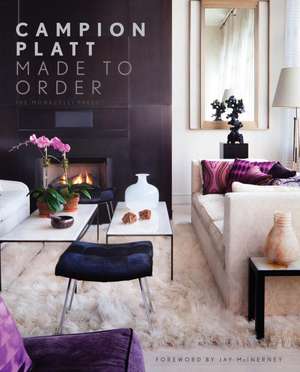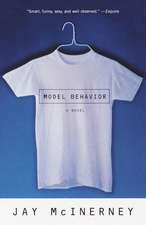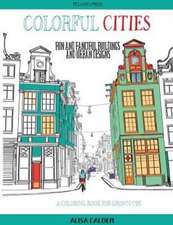Made to Order
Autor Campion Platt Jay McInerneyen Limba Engleză Hardback – 30 sep 2010
Every project is firmly rooted in the belief that handcrafting a home of one’s own should be a pleasure, and that an individualized, intensely personal interior can be achieved on any budget when an honest conversation is opened with a designer, or yourself, about what is most important in a home, and that this process will yield achievable, comfortable results. To that end, his firm creates spaces that are bespoke on many levels—each residence and all of its furnishings are literally made to order.
This lavish color presentation of over 200 images showcases the results of this unique approach in eighteen projects that range in size and location from demure city pied-à-terres to chic lofts and grand country estates. Conversational, engaging commentary and original sketches from the designer’s portfolio reveal his creative process, explain the inspiration from which each space’s theme is derived, disclose his most valuable tips, and explain how his experience has informed the creation of his own custom furniture, fabric, and carpet lines.
I discovered that Campion was almost obsessively concerned with fabrics and finishes, which resulted in a very visually rich environment.
—Jay McInerney
Preț: 362.75 lei
Nou
Puncte Express: 544
Preț estimativ în valută:
69.44€ • 71.42$ • 57.61£
69.44€ • 71.42$ • 57.61£
Carte disponibilă
Livrare economică 27 ianuarie-10 februarie
Livrare express 11-17 ianuarie pentru 82.17 lei
Preluare comenzi: 021 569.72.76
Specificații
ISBN-13: 9781580932806
ISBN-10: 1580932800
Pagini: 232
Ilustrații: 200 COLOR ILLUSTRATIONS
Dimensiuni: 229 x 305 x 25 mm
Greutate: 1.52 kg
Editura: Monacelli Press
ISBN-10: 1580932800
Pagini: 232
Ilustrații: 200 COLOR ILLUSTRATIONS
Dimensiuni: 229 x 305 x 25 mm
Greutate: 1.52 kg
Editura: Monacelli Press
Notă biografică
Campion Platt is principal of the award-winning New York interior design firm of the same name, founded in 1990, that has become a leader in boutique hotel design and is renowned for its highly customized interiors. Architectural Digest has named him to its AD100 list of top designers, and New York Magazine pronounced him one of “The City’s Best Architects and Decorators.” His work is featured regularly in Elle Décor, Esquire, Gotham, Travel + Leisure, Wallpaper, and other leading design magazines.
Jay McInerney is the author of Bright Lights, Big City and, most recently, How It Ended.
Jay McInerney is the author of Bright Lights, Big City and, most recently, How It Ended.
Extras
From: Telling a Story
Everyone has had the experience of telling a story, whether to a child at bedtime or to a bunch of friends over a glass of wine, or in some other context. But what might it mean to “tell a story” with architecture?
Here’s an example: A few years ago, I was asked by a Venezuelan couple to design their pied-à-terre in Manhattan. The apartment they had chosen posed a range of challenges, and I was at a loss as to how best to resolve them. While I was wrestling with the project, I went on a meditation retreat to Asia, and in the middle of it—remembering that my clients lived most of the year in the tropics—I had a vision of the pied-à-terre as a South American courtyard house: a place with an open-air entry garden, from which all of the home’s rooms and circulation paths would unfold. Typically, I develop concepts through a give-and-take with the architects and designers in my office, after devising a program with a client. This time, captivated by my theme, I sat down with a sketchbook and drew the entire apartment—from the broad organizational strokes to the rooms and the ways they communicated to the architectural details
and furnishings—in a matter of days.
The tale, as you will see in the coming pages, might also be about the lair of an old sea captain or inspired by a bunch of upper-crust Brits in colonial Africa. But whatever the case, my experience drove home one of the most valuable things I’ve learned: every successful project grows out of a story—and I can’t begin until I have found the story I want to tell.
This lesson, I should add, is not only of use to design professionals. Finding a story becomes especially important when you consider that 80 percent of home furnishings are purchased not by designers, but by people shopping for their own dwellings. I can’t count the number of times I’ve been asked to help out clients who had bought very beautiful, very costly vintage pieces by world-famous names—and wondered why nothing seemed to go together. The reason was that no unifying idea guided the design approach to their purchases.
Whether you’re a homeowner or a professional, finding a compelling story—or, if you prefer, a theme or concept—enables you to consider every decision with what amounts to a dependable true/false meter. At the largest scale, defining your inspiration helps to establish architectural principles that will organize the design—a courtyard house, for example, has certain signature elements upon which to draw. But having a story also helps with the details. Is this chair, wall covering, or rug contributing to the tale I want to tell? Or does it somehow strike a wrong note even though it’s beautiful or “important”? If you have developed a strong concept, you will make fewer mistakes, create interiors that are more original, imaginative, and authentically your own—and you will be practicing the craft of interior design rather than simply decorating.
Of course, the prospect of coming up with something that will drive all of a project’s design decisions can be daunting. The flip side of the equation is that every space has a story to tell—and so finding a story, at least in part, involves discovering what your home wants to be. If you’re at a loss, try jumpstarting the process by taking your cues from the architecture. Once you’ve got a dialogue going, everything that flows from it will be functional, beautiful, and welcoming.
Having said all this, let me add a caveat: if your theme just does not seem to be working after a few tries, don’t be afraid to move on. There’s a Buddhist saying: “The only way out is in.” Immerse yourself in the process—and you will come out with the right story to tell.
Everyone has had the experience of telling a story, whether to a child at bedtime or to a bunch of friends over a glass of wine, or in some other context. But what might it mean to “tell a story” with architecture?
Here’s an example: A few years ago, I was asked by a Venezuelan couple to design their pied-à-terre in Manhattan. The apartment they had chosen posed a range of challenges, and I was at a loss as to how best to resolve them. While I was wrestling with the project, I went on a meditation retreat to Asia, and in the middle of it—remembering that my clients lived most of the year in the tropics—I had a vision of the pied-à-terre as a South American courtyard house: a place with an open-air entry garden, from which all of the home’s rooms and circulation paths would unfold. Typically, I develop concepts through a give-and-take with the architects and designers in my office, after devising a program with a client. This time, captivated by my theme, I sat down with a sketchbook and drew the entire apartment—from the broad organizational strokes to the rooms and the ways they communicated to the architectural details
and furnishings—in a matter of days.
The tale, as you will see in the coming pages, might also be about the lair of an old sea captain or inspired by a bunch of upper-crust Brits in colonial Africa. But whatever the case, my experience drove home one of the most valuable things I’ve learned: every successful project grows out of a story—and I can’t begin until I have found the story I want to tell.
This lesson, I should add, is not only of use to design professionals. Finding a story becomes especially important when you consider that 80 percent of home furnishings are purchased not by designers, but by people shopping for their own dwellings. I can’t count the number of times I’ve been asked to help out clients who had bought very beautiful, very costly vintage pieces by world-famous names—and wondered why nothing seemed to go together. The reason was that no unifying idea guided the design approach to their purchases.
Whether you’re a homeowner or a professional, finding a compelling story—or, if you prefer, a theme or concept—enables you to consider every decision with what amounts to a dependable true/false meter. At the largest scale, defining your inspiration helps to establish architectural principles that will organize the design—a courtyard house, for example, has certain signature elements upon which to draw. But having a story also helps with the details. Is this chair, wall covering, or rug contributing to the tale I want to tell? Or does it somehow strike a wrong note even though it’s beautiful or “important”? If you have developed a strong concept, you will make fewer mistakes, create interiors that are more original, imaginative, and authentically your own—and you will be practicing the craft of interior design rather than simply decorating.
Of course, the prospect of coming up with something that will drive all of a project’s design decisions can be daunting. The flip side of the equation is that every space has a story to tell—and so finding a story, at least in part, involves discovering what your home wants to be. If you’re at a loss, try jumpstarting the process by taking your cues from the architecture. Once you’ve got a dialogue going, everything that flows from it will be functional, beautiful, and welcoming.
Having said all this, let me add a caveat: if your theme just does not seem to be working after a few tries, don’t be afraid to move on. There’s a Buddhist saying: “The only way out is in.” Immerse yourself in the process—and you will come out with the right story to tell.
Recenzii
"It's a book that's spare and sumptuous at once . . . It is, as McInerney wrote in his foreword to 'Made to Order,' a matter of 'modernism with soul.'"
—Architects + Artisans
"Platt’s accompanying essays include plenty of practical design advice."
—Palm Beach Daily News
"For the latest home makeover trends check out the new design book by architect Campion Platt."
—Karen Mills Interior Design Blog
—Architects + Artisans
"Platt’s accompanying essays include plenty of practical design advice."
—Palm Beach Daily News
"For the latest home makeover trends check out the new design book by architect Campion Platt."
—Karen Mills Interior Design Blog
Cuprins
Foreword by Jay McInerney
Introduction
Telling a Story
Tropical Mischief
Jewel Box
Captain's House
Heaven's Chamber
Open Spaces
White Loft
Modern Restoration
Manhattan House
Apartment Living
Fifth Avenue Art House
Murray Hill Townhouse
Contrasts
Hudson Valley Pastoral
Carnegie Hill Zen
Highrise Redux
Nature and Craft
Sky Lounge
Country Manor
City Hues
Tribeca Loft
Solutions
Astor Place
Writer's Retreat
Acknowledgments
Photography Credits
Introduction
Telling a Story
Tropical Mischief
Jewel Box
Captain's House
Heaven's Chamber
Open Spaces
White Loft
Modern Restoration
Manhattan House
Apartment Living
Fifth Avenue Art House
Murray Hill Townhouse
Contrasts
Hudson Valley Pastoral
Carnegie Hill Zen
Highrise Redux
Nature and Craft
Sky Lounge
Country Manor
City Hues
Tribeca Loft
Solutions
Astor Place
Writer's Retreat
Acknowledgments
Photography Credits










